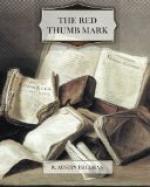“A drop of blood from a living body falling upon any non-absorbent surface will, in the course of a few minutes, solidify into a jelly which will, at first, have the same bulk and colour as the liquid blood.”
“Will it undergo any further change?”
“Yes. In a few minutes more the jelly will begin to shrink and become more solid so that the blood will become separated into two parts, the solid and the liquid. The solid part will consist of a firm, tough jelly of a deep red colour, and the liquid part will consist of a pale yellow, clear, watery liquid.”
“At the end, say, of two hours, what will be the condition of the drop of blood?”
“It will consist of a drop of clear, nearly colourless liquid, in the middle of which will be a small, tough, red clot.”
“Supposing such a drop to be taken up on a piece of white paper, what would be its appearance?”
“The paper would be wetted by the colourless liquid, and the solid clot would probably adhere to the paper in a mass.”
“Would the blood on the paper appear as a clear, red liquid?”
“Certainly not. The liquid would appear like water, and the clot would appear as a solid mass sticking to the paper.”
“Does blood always behave in the way you have described?”
“Always, unless some artificial means are taken to prevent it from clotting.”
“By what means can blood be prevented from clotting or solidifying?”
“There are two principal methods. One is to stir or whip the fresh blood rapidly with a bundle of fine twigs. When this is done, the fibrin—the part of the blood that causes solidification—adheres to the twigs, and the blood that remains, though it is unchanged in appearance, will remain liquid for an indefinite time. The other method is to dissolve a certain proportion of some alkaline salt in the fresh blood, after which it no longer has any tendency to solidify.”
“You have heard the evidence of Inspector Sanderson and Sergeant Bates?”
“Yes.”
“Inspector Sanderson has told us that he examined the safe at 10.31 a.m. and found two good-sized drops of blood on the bottom. Sergeant Bates has told us that he examined the safe two hours later, and that he took up one of the drops of blood on a piece of white paper. The blood was then quite liquid, and, on the paper, it looked like a clear, red liquid of the colour of blood. What should you consider the condition and nature of that blood to have been?”
“If it was really blood at all, I should say that it was either defibrinated blood—that is, blood from which the fibrin has been extracted by whipping—or that it had been treated with an alkaline salt.”
“You are of opinion that the blood found in the safe could not have been ordinary blood shed from a cut or wound?”
“I am sure it could not have been.”
“Now, Dr. Rowe, I am going to ask you a few questions on another subject. Have you given any attention to finger-prints made by bloody fingers?”




